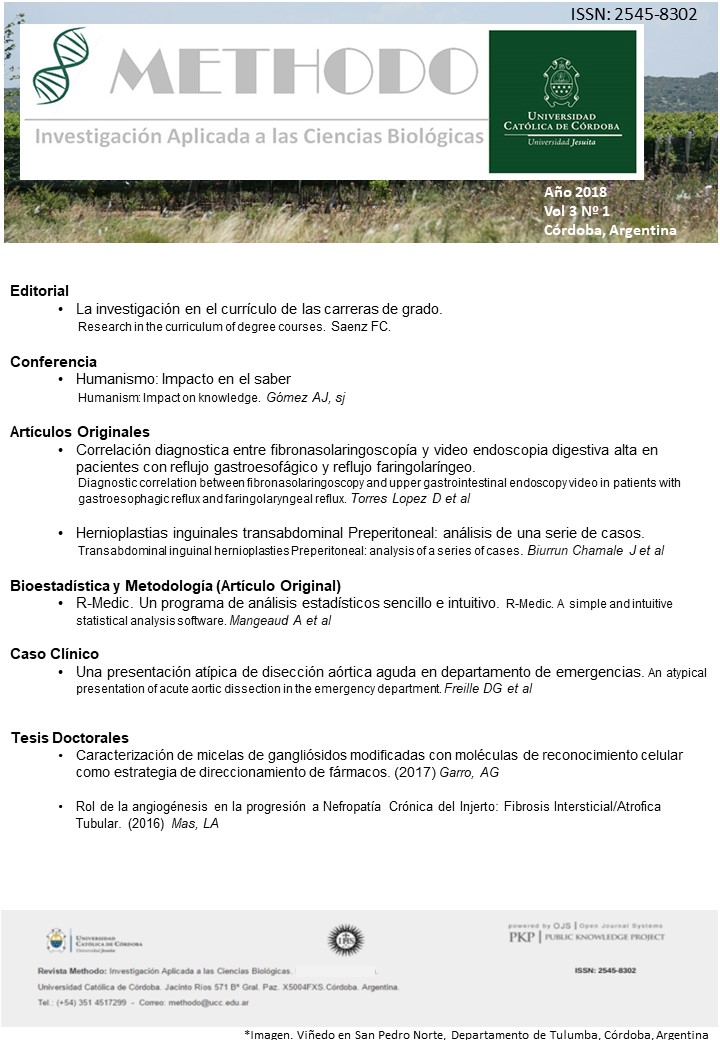Hernioplastias inguinales transabdominal Preperitoneal: análisis de una serie de casos
DOI:
https://doi.org/10.22529/me.2018.3(1)%2004Palabras clave:
hernioplastia, hernioplastia inguinal laparoscópica, preperitoneal, transabdominalResumen
La hernia inguinal tiene una incidencia entre 6,3 y 23,5 hernias por 10.000 habitantes, siendo uno de los procedimientos más comunes en cirugía, con más de 20 millones de reparaciones globales por año. Una de las técnicas de abordaje por videolaparoscopía es la vía transabdominal preperitoneal (TAPP)Descargas
Referencias
Bernhardt G, Gruber G, Molderings B, Cerwenka H,Glehr M, Giessauf C, et al. Healthrelated quality of life ater TAPP repair for the sportsmen's groin. Surg Endosc (2014) 28:439-446 https://doi.org/10.1007/s00464-013-3190-2
Kulacoglu H. Current options in inguinal hernia repair in adult patients. Hippokratia 2011; 15: 223-31.
Ger R. The management of certain abdominal herniae by intra-abdominal closure of the neck of the sac. Preliminary communication. Ann R Coll Surg Engl. 1982;64:342-4.
McKernan JB, Laws HL. Laparoscopic repair of inguinal hernias using a totally extraperitoneal prosthetic approach. Surg Endosc 1993; 7: 26-28. https://doi.org/10.1007/BF00591232
Arregui ME, Davis CJ, Yucel O, Nagan RF. Laparoscopic mesh repair of inguinal hernia using a preperitoneal approach: a preliminary report. Surg Laparosc Endosc. 1992;2:53-8.
Simons MP, Aufenacker T, BayNielsen M, Bouillot JL,Campanelli G, Conze J, et al. European Hernia Societyguidelines on the treatment of inguinal hernia in adultpatients. Hernia. 2009;13:343-403. https://doi.org/10.1007/s10029-009-0529-7
McCormack K, Wake BL, Perez J, Fraser C, Cook J, McIntosh E,et al. Laparoscopic surgery for inguinal hernia repair:Systemic review of effective- ness and economic evaluation.Health Technol Assess. 2005;9:1-203. https://doi.org/10.3310/hta9140
Misra MC, Kumar S, Bansal VK. Total extraperitoneal (TEP)mesh repair of inguinal hernia in the developing world:Comparison of low-cost indigenous balloon dissection versusdirect telescopic dissection: A prospective randomizedcontrolled study. Surg Endosc. 2008;22:1947-58. https://doi.org/10.1007/s00464-008-9897-9
Voitk AJ. The learning curve in laparoscopic inguinal herniarepair for the community general surgeon. Can J Surg.1998;41:446-50.
Barrat C, Voreux JP, Occelli G, Catheline JM, Champault G.Effects of surgical education and training on the results oflaparoscopic treatment of inguinal hernias. Chirurgie.1999;124:298-303. https://doi.org/10.1016/S0001-4001(99)80096-8
Maddern GJ, Rudkin G, Bessell JR, Devitt P, Ponte L. Acomparison of laparoscopic and open hernia repair as a daysurgical procedure. Surg Endosc. 1994;8:1404-8. https://doi.org/10.1007/BF00187345
Poobalan AS, Bruce J, Smith WC, King PM, Krukowski ZH,Chambers WA. A review of chronic pain after inguinalherniorrhaphy. Clin J Pain. 2003;19:48-54. https://doi.org/10.1097/00002508-200301000-00006
Roll S. A global vision for hernia repair improvement. GenSurg News. 2012;39:01.
Belyansky I, Tsirline V, Klima D, Walters A, Lincourt A,Heniford T. Prospective, comparative study of postoperativequality of life in TEP, TAPP, and modified Lichtenstein repairs.Ann Surg. 2011;254:709-15. https://doi.org/10.1097/SLA.0b013e3182359d07
Lau H. Fibrin sealant versus mechanical stapling for meshfixation during endoscopic extraperitoneal inguinalhernioplasty: A randomized prospective trial. Ann Surg.2005;242:670-5. https://doi.org/10.1097/01.sla.0000186440.02977.de
Kukleta JF, Freytag C, Weber M. Efficiency and safety of meshfixation in laparoscopic inguinal hernia repair using nbutylcyanoacrylate: Long-term biocompatibility in over 1,300 meshfixations. Hernia. 2012;16:153-62 https://doi.org/10.1007/s10029-011-0887-9
Zhang C, Li F, Zhang H, Zhong W, Shi D, Zhao Y. Selfgrippingversus sutured mesh for inguinal hernia repair: A systematicreview and metaanalysis of current literature. J Surg Res.2013;185:653-60 https://doi.org/10.1016/j.jss.2013.07.035
Bresnahan E, Bates A, Wu A, Reiner M, Jacob B. The use ofself-gripping (ProgripTM) mesh during laparoscopic totalextraperitoneal (TEP) inguinal hernia repair: A prospectivefeasibility and longterm outcomes study. Surg Endosc.2015;29:2690-6. Epub 2014 Dec 18. Erratum in: Surg Endosc.2015 Sep;29(9):2697. https://doi.org/10.1007/s00464-014-3991-y
Callesen T. Inguinal hernia repair: Anaesthesia, pain andconvalescence. Dan Med Bull. 2003;50:203-18.
Salcedo-Wasicek MC, Thirlby RC. Postoperative course afteringuinal herniorrhaphy. A case-controlled comparison ofpatients receiving workers compensation vs. patients withcommercial insurance. Arch Surg. 1995;130:29-32. https://doi.org/10.1001/archsurg.1995.01430010031006
Wright D, Paterson C, Scott N, Hair A, O'Dwyer PJ. Fiveyearfollow-up of patients undergoing laparoscopic or open groinhernia repair: A randomized controlled trial. Ann Surg.2002;235:333-7 https://doi.org/10.1097/00000658-200203000-00004












